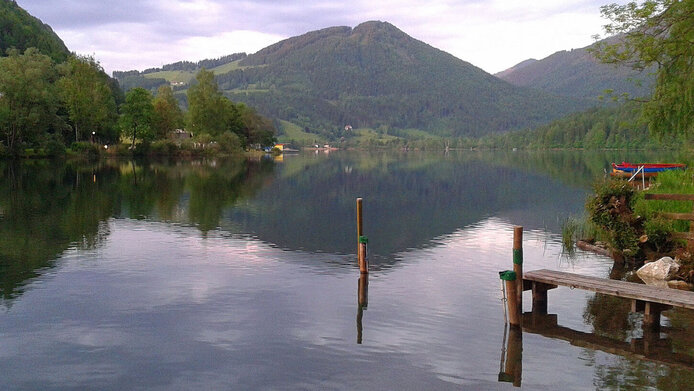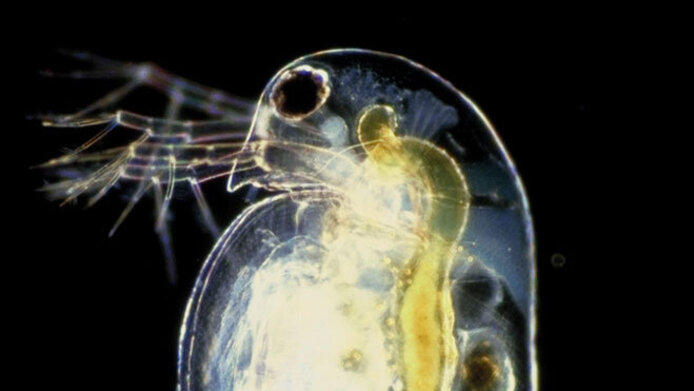Food enhancement by algae parasites

Algae are at the lowest level of the food chains in bodies of water. As long as they are smaller than 30 micrometers, they can easily be eaten by zooplankton such as daphnia (water fleas) or copepods. Because of higher temperatures and higher nutrient inputs from agriculture, sewage treatment plants or atmospheric nitrogen, one finds, however, an increase in the proliferation of larger and filamentous (thread-like) algae and cyanobacteria in lakes and ponds, some of which are toxic. While one would assume that owing to this fact little or no zooplankton can be found in such waters, this is not the case.
During her doctoral studies in France, the limnologist Serena Rasconi was already investigating how this is possible. She came across fungi (chytrids) that live on algae as parasites. A crucial role is played by the so-called zoospores which the chytrids emit after the parasitic stage. These zoospores float in the water until they encounter a new host.
After her PhD at WasserCluster Lunz, Serena Rasconi had submitted a project funded by the Austrian Science Fund FWF to study the role of these chytrids in the planktonic food web. When Rascone joined the National Research Institute for Agriculture, Food and Environment (INRAE) in France, the water ecologist Martin Kainz took over from her as principal investigator: “We wanted to investigate whether the zoospores are only the ‘couriers’ that transport nutrients from the cyanobacteria, or whether they also cause trophic upgrading, which means processing and improving the energy.” A series of experiments was launched to find the answer.
Experiment with heavy water
In the first experiment, the unique technical equipment of the WasserCluster Lunz, which is located in Lower Austria, came to play a decisive role. As Kainz proudly notes: “We are the only laboratory in the world that does component-specific hydrogen isotope research in relation to fatty acids and is able to use deuterium, or heavy hydrogen, for this purpose. In this way we can determine the ratio between protium and deuterium in fatty acids.” The researchers can thus prove that the chytrid zoospores can actually synthesize polyunsaturated fatty acids and even long-chain unsaturated omega-3 fatty acids – a fact that was previously unknown, as Kainz explains. “This is a physiological property that is enormously important, because in its absence the diet of consumers such as daphnia or other zooplankters would be poorer.”
With all due scientific caution, the researcher posits that an increase in cyanobacteria on account of an increase in water temperature in lakes, owing to climate change, could be mitigated somewhat by this ability of the chytrids. He adds that it is as yet unknown whether this ability would still exist at even higher temperatures.

Fitness test for zooplankton
In a second step, the group in Lunz investigated whether the improvement in nutrition that is due to the fatty acids also has an effect on the zooplankton. In the laboratory they observed the fitness of daphnia in terms of their survival, growth and reproduction. Some were fed only Planktothrix, which are smaller cyanobacteria, while the others also had chytrids in the water. In the Planktothrix group, 90 percent of the daphnia survived, in the other 100 percent. The daily growth rate was ten percent in the chytrid group and only four percent, a very slow growth rate, in the group that only fed on cyanobacteria. There was also a significant difference in reproduction: the daphnia in the chytrid group produced eggs, while the others did not.
The effect of the parasitic fungi even leads to the daphnia being able to synthesize and store a great deal more energy in the form of fats. “The key message of our results is that in research we really need to understand the food chain as a chain, and every link in this chain is essential,” says Martin Kainz. In a third step, the postdoc András Abonyi investigated whether there are differences in these mechanisms at a water temperature between 18 and 24 degrees. These results have not yet been published.
However, despite all the enthusiasm for this adaptive capacity of the aquatic ecosystem, Martin Kainz warns against humankind relaxing and thinking that nature will fix whatever we do to interfere with it: “We really need to understand the function of ecosystems well and maintain these functions so that we don't disrupt the food chain even further.”
Personal details
Martin Kainz is a researcher and scientific director at the Inter-university Center for Aquatic Ecosystem Research at WasserCluster in Lunz am See. He is the leader of the Aquatic Lipids and Ecotoxicology (Liptox) research group there. Martin Kainz studied landscape ecology at the University of Vienna and received his PhD in environmental sciences from the Université du Québec in Montréal, Canada. He completed his professorial qualification in aquatic ecology and ecotoxicology at the University of Vienna. The project “Effects of parasites on plankton communities” (2017–2022) received around EUR 392,000 in funding from the Austrian Science Fund FWF.
More information: Kainz Lab - Trophic Ecology
Publications
Abonyi A., Rasconi S., Ptacnik R., Pilecky M., Kainz M.: Chytrids enhance Daphnia fitness by selectively retained chytrid-synthesised stearidonic acid and conversion of short-chain to long-chain polyunsaturated fatty acids, in: Freshwater Biology Nov. 2022
Rasconi S., Ptacnik R., Danner S., Van den Wyngaert S., Rohrlack T., Pilecky M., Kainz M.: Parasitic Chytrids Upgrade and Convey Primary Produced Carbon During Inedible Algae Proliferation, in: Protist, 171(5), 2020





